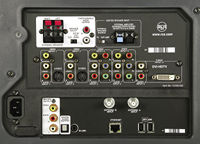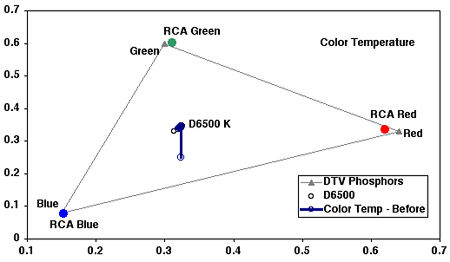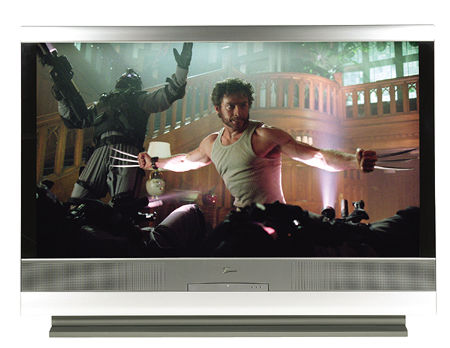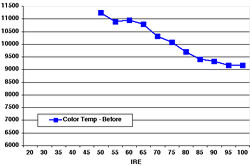The 2004 HD Rear-Projection Face Off Page 1
In every Face Off, someone has to come in last. In this case, the dubious honor falls to the RCA HDLP61W151. Pigeonholing it as a last-place performer isn't entirely fair, as it does a number of things right. However, it has two issues that prevented it from placing any higher.

On the first day of the Face Off, I set all of the TVs' light output at the same level, around 30 ft-L. In the case of the RCA, achieving this level meant that I had to turn the contrast all the way to zero. Like all of the other fixed-pixel displays, comments like "flat" and "washed out" abounded for the RCA.
 On day two, I set all of the TVs' light output to the maximum level that they could achieve without either blooming or crushing the whites. In the RCA's case, that amount was over 100 ft-L, by far the brightest in the Face Off. The black-level criticisms subsided somewhat but still not enough to move the RCA into a higher position. Under many conditions, the RCA's extreme light output would make it seem like it had a decent black level; however, when you place this TV next to sets that really do have a deep black level, it appears washed-out. For those of you who need a really bright TV to counteract the sun or your room's lights, this is the set for you. In fact, Amy thought this would be a good football-watching TV, the kind of TV you'd want on Sunday afternoon so that all your friends could come over and watch the game.
On day two, I set all of the TVs' light output to the maximum level that they could achieve without either blooming or crushing the whites. In the RCA's case, that amount was over 100 ft-L, by far the brightest in the Face Off. The black-level criticisms subsided somewhat but still not enough to move the RCA into a higher position. Under many conditions, the RCA's extreme light output would make it seem like it had a decent black level; however, when you place this TV next to sets that really do have a deep black level, it appears washed-out. For those of you who need a really bright TV to counteract the sun or your room's lights, this is the set for you. In fact, Amy thought this would be a good football-watching TV, the kind of TV you'd want on Sunday afternoon so that all your friends could come over and watch the game.
 The light output didn't have anything to do with the RCA's other main issue: color. It just didn't have enough of it. When compared with some of the other TVs' oversaturated colors, some reviewers didn't mind the RCA's undersaturated colors, but this only added to the washed-out comments. It's too bad, as the RCA's gray-scale tracking is excellent, among the best in the Face Off. It's also too bad that there's no way to calibrate the TV, so you're stuck with either a slightly warm image or a slightly cool one, depending on what color temperature you pick.
The light output didn't have anything to do with the RCA's other main issue: color. It just didn't have enough of it. When compared with some of the other TVs' oversaturated colors, some reviewers didn't mind the RCA's undersaturated colors, but this only added to the washed-out comments. It's too bad, as the RCA's gray-scale tracking is excellent, among the best in the Face Off. It's also too bad that there's no way to calibrate the TV, so you're stuck with either a slightly warm image or a slightly cool one, depending on what color temperature you pick.
It was a close race between this set, the Samsung, and the Zenith for the most attractive cabinet. The silver chassis with the black panel around the screen is an excellent combo. The subtle blue lights that shine on the buttons is a classy touch that you can turn off if you prefer. The remote is a departure from the standard (and begrudgingly beloved) RCA remote. It's thin, fits comfortably in your hand, and has backlighting for most of the important buttons.
Another aspect of this TV should have earned it a higher ranking. At $4,000, it's an excellent value. It's only $200 more than the other two DLP sets, yet, diagonally, it's 5 inches larger than the Gateway and 15 inches larger than the Samsung. It's also the only fixed-pixel TV in the Face Off with a built-in HDTV tuner.
It surprised me that the HDLP61W151 didn't place higher, but it seems that black level still is a strong factor in people's opinions of TVs. That said, the RCA is a full-featured, extremely bright and attractive TV for those people who do less of their viewing in the dark and more during the day.

HDLP61W151 61-Inch HDTV $4,000
RCA
(800) 336-1900
www.rca.com
Dealer Locator Code RCA
HT Labs Measures: RCA HDLP61W151 HDTV


The top chart shows the gray scale of the HDLP61W151 relative to its color temperature at various levels of intensity, or brightness (20 IRE is dark gray; 100 IRE is bright white). The gray scale as set by the factory, in the personal mode, measures somewhat red across the gray scale. No calibration or gray-scale adjustments were possible with this TV. The bottom chart shows the gray scale (or color temperature) relative to the color points of the display's red, green, and blue color-filter-wheel segments. Red (x=0.620, y=0.335), green (x=0.311, y=0.601), and blue (x=0.153, y=0.076) are close to those specified by SMPTE, although red is undersaturated and green is slightly yellow. The light output was approximately 116 foot-lamberts. The display has good DC restoration and a decent color decoder. The HDLP61W151 displays out to DVD's limits and, using our Leader LT-446 HD generator, is capable of 1080i out to the limits of its 1,280-by-720 chip. Bizarrely, the TV does not accept external 720p signals.—GM
Zenith D60WLCD (LCD, $3,700)
The Zenith D60WLCD was the least expensive fixed-pixel display in the Face Off. This is even more impressive when you consider that the two closest competitors in price are both several inches smaller in screen size. One of two LCD sets in the Face Off, the Zenith had its share of strengths and weaknesses.

Like the RCA, the Zenith didn't fare well on day one. It just didn't like having its contrast turned down so low. Comments like "muted" and "flat" peppered the panelists' pages. Without the extreme light output that this set is capable of, it was hard not to notice its high black level. Because of this, most reviewers ranked it low. That changed on day two. Here, the Zenith was allowed some breathing room, and its scores jumped considerably. Out of all of the reviewers, Maureen liked this set the best, particularly with HD material. She felt it had great detail, good color, and a bright image. Amy also liked the color, but no reviewer liked the color temperature.
 The Zenith's Achilles heel is its lack of a color-temperature control. To make matters worse, its out-of-the-box color temperature is extremely blue, far cooler than any other set in the Face Off. This didn't go unnoticed amongst our panel. Most thought that it was just too blue for their liking, although on day two most reviewers felt that this set had enough other strengths to rank it fairly high. Detail was the quality most often praised. The reviewers who still didn't like the set on day two just couldn't get over the color temperature.
The Zenith's Achilles heel is its lack of a color-temperature control. To make matters worse, its out-of-the-box color temperature is extremely blue, far cooler than any other set in the Face Off. This didn't go unnoticed amongst our panel. Most thought that it was just too blue for their liking, although on day two most reviewers felt that this set had enough other strengths to rank it fairly high. Detail was the quality most often praised. The reviewers who still didn't like the set on day two just couldn't get over the color temperature.
 Everyone agreed that the Zenith has a very attractive aesthetic. As I mentioned before, the Zenith, RCA, and Samsung TVs ran a close race for best-looking cabinetry, with no clear winner. Jerry liked how the Zenith balanced the silver of the cabinet with the black surrounding the picture. Maureen thought the Zenith was "very attractive," which was her highest praise for aesthetics in the Face Off. The remote, although on the large side, is backlit (if you can find the light button) and is well laid-out.
Everyone agreed that the Zenith has a very attractive aesthetic. As I mentioned before, the Zenith, RCA, and Samsung TVs ran a close race for best-looking cabinetry, with no clear winner. Jerry liked how the Zenith balanced the silver of the cabinet with the black surrounding the picture. Maureen thought the Zenith was "very attractive," which was her highest praise for aesthetics in the Face Off. The remote, although on the large side, is backlit (if you can find the light button) and is well laid-out.
Value is where the D60WLCD excels. At $3,700, you get more for your fixed-pixel dollar than any other set in the Face Off, even if the TV does have its flaws. Zenith's parent company LG Electronics has also released a new LCD RPTV, the RU-60SZ30, that only costs $300 more. Unfortunately, it wasn't available in time for this competition. It has a DVI input with HDCP (which the D60WLCD lacks) and a glare-reducing screen (great for daytime viewing). Most importantly, it has a color-temperature control. Take that problem out of the equation, and you've got a set that's well worth a look.
For the price, it's hard to overlook the D60WLCD. It's bright, attractive, and detailed. That said, for a few hundred more, the new set from LG offers more functionality and eliminates the number-one problem that people had with this TV. Either way, you're getting a good deal for your money.

D60WLCD 60-Inch HD Monitor $3,700
Zenith Electronics
(877) 9ZENITH
www.zenith.com
Dealer Locator Code ZEN
HT Labs Measures: Zenith D60WLCD HD Monitor


The top chart shows the gray scale of the D60WLCD relative to its color temperature at various levels of intensity, or brightness (20 IRE is dark gray; 100 IRE is bright white). The gray scale as set by the factory, in the movie mode, is too far off the black body curve to measure with dark images and fairly blue with brighter images. No calibration or gray-scale adjustments were possible with this TV. The bottom chart shows the gray scale (or color temperature) relative to the color points of the display's red, green, and blue liquid crystals. Red (x=0.644, y=0.337), green (x=0.298, y=0.670), and blue (x=0.149, y=0.080) are close to those specified by SMPTE with the exception of green, which is oversaturated. The light output was approximately 80 foot-lamberts. The display has good DC restoration and a decent color decoder. The D60WLCD displays approximately 480 lines (per picture height) with NTSC sources and, using our Leader LT-446 HD generator, is capable of resolving 720p signals out to 510 (pph) and 1080i out to 710 (pph).—GM
- Log in or register to post comments































































